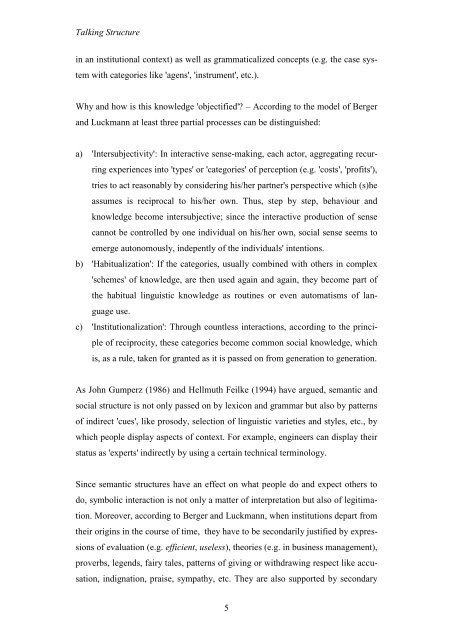In organisation theory, bridging the gap between „micro“ and „macro ...
In organisation theory, bridging the gap between „micro“ and „macro ...
In organisation theory, bridging the gap between „micro“ and „macro ...
You also want an ePaper? Increase the reach of your titles
YUMPU automatically turns print PDFs into web optimized ePapers that Google loves.
Talking Structure<br />
in an institutional context) as well as grammaticalized concepts (e.g. <strong>the</strong> case sys-<br />
tem with categories like 'agens', 'instrument', etc.).<br />
Why <strong>and</strong> how is this knowledge 'objectified'? – According to <strong>the</strong> model of Berger<br />
<strong>and</strong> Luckmann at least three partial processes can be distinguished:<br />
a) '<strong>In</strong>tersubjectivity': <strong>In</strong> interactive sense-making, each actor, aggregating recur-<br />
ring experiences into 'types' or 'categories' of perception (e.g. 'costs', 'profits'),<br />
tries to act reasonably by considering his/her partner's perspective which (s)he<br />
assumes is reciprocal to his/her own. Thus, step by step, behaviour <strong>and</strong><br />
knowledge become intersubjective; since <strong>the</strong> interactive production of sense<br />
cannot be controlled by one individual on his/her own, social sense seems to<br />
emerge autonomously, indepently of <strong>the</strong> individuals' intentions.<br />
b) 'Habitualization': If <strong>the</strong> categories, usually combined with o<strong>the</strong>rs in complex<br />
'schemes' of knowledge, are <strong>the</strong>n used again <strong>and</strong> again, <strong>the</strong>y become part of<br />
<strong>the</strong> habitual linguistic knowledge as routines or even automatisms of lan-<br />
guage use.<br />
c) '<strong>In</strong>stitutionalization': Through countless interactions, according to <strong>the</strong> princi-<br />
ple of reciprocity, <strong>the</strong>se categories become common social knowledge, which<br />
is, as a rule, taken for granted as it is passed on from generation to generation.<br />
As John Gumperz (1986) <strong>and</strong> Hellmuth Feilke (1994) have argued, semantic <strong>and</strong><br />
social structure is not only passed on by lexicon <strong>and</strong> grammar but also by patterns<br />
of indirect 'cues', like prosody, selection of linguistic varieties <strong>and</strong> styles, etc., by<br />
which people display aspects of context. For example, engineers can display <strong>the</strong>ir<br />
status as 'experts' indirectly by using a certain technical terminology.<br />
Since semantic structures have an effect on what people do <strong>and</strong> expect o<strong>the</strong>rs to<br />
do, symbolic interaction is not only a matter of interpretation but also of legitima-<br />
tion. Moreover, according to Berger <strong>and</strong> Luckmann, when institutions depart from<br />
<strong>the</strong>ir origins in <strong>the</strong> course of time, <strong>the</strong>y have to be secondarily justified by expres-<br />
sions of evaluation (e.g. efficient, useless), <strong>the</strong>ories (e.g. in business management),<br />
proverbs, legends, fairy tales, patterns of giving or withdrawing respect like accu-<br />
sation, indignation, praise, sympathy, etc. They are also supported by secondary<br />
5














